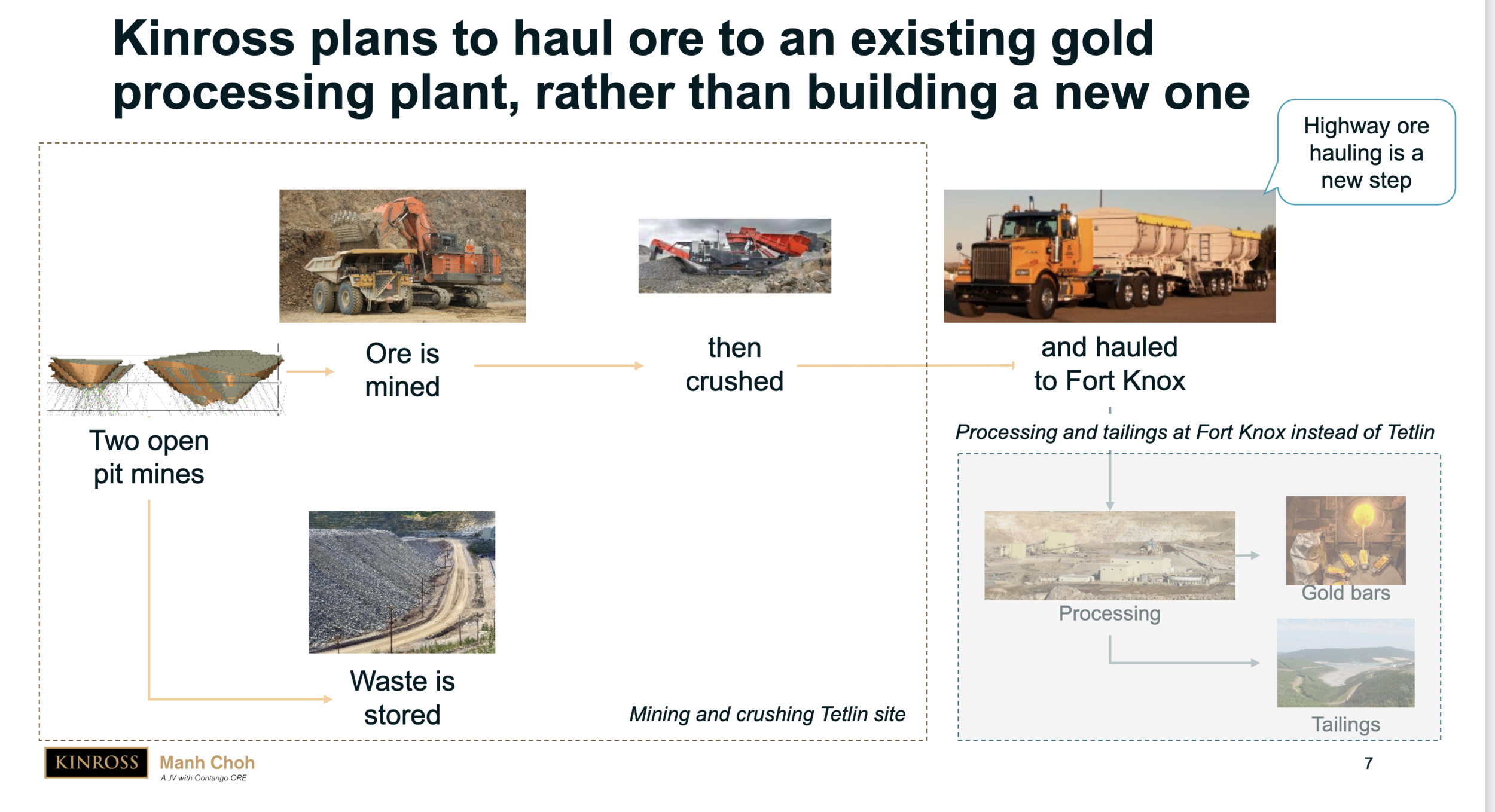Kinross plan to add 24-hour heavy truck traffic across Interior Alaska would be a public safety nightmare
Traveling winter or summer on the Richardson Highway from Tok to Fairbanks and the Steese Highway from Fairbanks to Cleary Summit would become far more dangerous and inconvenient under the Kinross plan to transform it into a 250-mile industrial route for heavy truck traffic, hauling 10 million pounds of rock every day of the year.
Let’s get this out in the open for purposes of discussion.
The Fort Knox mill is an expensive piece of infrastructure that is underutilized, the company says. The Canadian company is shifting its operations to depend on more trucked-in rock, envisioning the use of public roads to expand its reach by hundreds of miles.
As Fort Knox General Manager Jeremy Brans told Mining News North in 2020, "It is no longer just 'Kinross Fort Knox'; it is 'Kinross Alaska . . . with Fort Knox at its heart'."
“Without the need to outline a project large enough to support the time and money investment to build gold recovery and tailings disposal system, Kinross Alaska will change how gold exploration companies evaluate and explore road, rail or river accessible assets within Fort Knox's economic radius,” Mining News North said.
The Tetlin plan, which Kinross expects to produce large profits, could provide close to the equivalent of 1 million ounces of gold in the initial 4.5-year period.
The plan to truck gold-bearing rock to Fort Knox is a low-cost, “attractive high-margin project that is expected to generate robust returns,” Kinross Gold President J. Paul Rollinson told investors in 2020.
It’s an “attractive, high-margin project,” in part, because the costs to public safety and infrastructure are not included in the company’s calculation and are assumed to be paid for by the public. Company officials have also called it a project with “low risk,” neglecting to include an assessment of the public safety risks.
The 120-foot trucks will be running every 7.5 minutes in one direction or the other, operating all day, every day. There will be increased road damage and more accidents. When there are delays for road construction projects, the trucks will get backed up along with everyone else.
The plan to haul rock on public roads would also change the nature of highway travel in the Fairbanks area and not for the better. That needs to be part of the Fort Knox evaluation, along with the mining tax rates set in 1955, a topic that elected officials have ignored for decades.
Gov. Mike Dunleavy and his administration have shown no sign that they recognize the obvious public safety, highway maintenance and other costs arising from this proposal. Where is the analysis of this proposal by the state?
The state even secretly invested $10 million of public money directly in the project without informing the public or asking for comment. The $10 million investment was made by the Alaska Permanent Fund under a program that fund managers say allows them to make secret investments in Alaska projects.
We only know about the $10 million investment because the recipient of the money, a minor partner in the venture, decided it was good business strategy to announce this as a show that the state is endorsing the plan. The $10 million “demonstrates the excitement around building Alaska’s next gold mine in partnership with Kinross and the Tetlin tribe,” Contango CEO Rick Van Nieuwenhuyse said in a press release last June.
Contango Ore recognizes that there is value in telling potential investors that the Alaska Permanent Fund is an investor, and therefore the project is backed by the state. With this investment, the state is paying for a portion of exploration and development of the Manh Choh project, and is a silent partner with Kinross Gold.
The Fairbanks News-Miner has not examined the ore trucking plan in a serious fashion.
Former Sen. Gary Wilken has taken an important first step with this six-page letter that highlights what we need to know before this plan moves ahead. He’s thought of many things that I haven’t considered—from school buses and ambulance service to the prospect that Alaska Highway RV travelers will stop coming to Fairbanks and will head to Anchorage from Tok to avoid the trucks. Plus, it is unlikely that this project would be limited to 4.5 years, as the promoters say. That would be the first stage.
Wilken says the sketchy details released of the Kinross plan so far amount to an “extraordinary threat to the safety of Alaskans” and asks the company to look at alternatives to using public roads. He’s right.
There is not only the matter of passing the trucks in the summer in good conditions—which will be hazardous enough—winter travel on ice and especially in fresh snow will be a daily disaster.
Wilken said possible alternatives include processing the ore on the site at Tetlin, building an industrial road and expansion of the Alaska Railroad.
“The Kinross Ore Transport Plan increases the very risk our state government should be minimizing,” Wilken wrote.
Kinross hopes to get the equivalent value of 1 million ounces of gold from the initial project, which would last 4.5 years.
The promotional materials for the Manh Choh project say that by using existing infrastructure, which includes the Richardson and Steese highways, the project is on the fast track and will produce more profits. The promotional materials don’t mention anything about the state’s dwindling budget for road repairs, public safety and the impacts of running mining trucks every 7.5 minutes, perhaps for decade to come.
Your contributions help support independent analysis and political commentary by Alaska reporter and author Dermot Cole. Thank you for reading and for your support. Either click here to use PayPal or send checks to: Dermot Cole, Box 10673, Fairbanks, AK 99710-0673.

